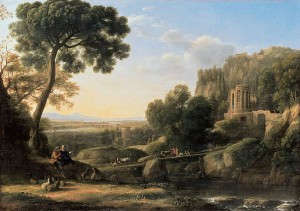
For many years I have admired the work of the old master, Claude Lorrain, or to give him his proper name, Claude Gellee. He was born in either 1604/5 no one is quite sure, in Champagne in the Duchy of Lorraine. (Isn’t that the best place to be born)? He was a French painter, engraver and draughtsman who spent all his adult life living in Rome where he painted the most sublime landscapes. Foreign artists at that time, were excluded from painting religious works, reserved for the Italians, but that suited Claude’s love of landscape painting. His style was paralelled by his contemporary Nicholas Poussin, also French and living in Rome. Claude, as the English knew him, evolved an original and personal style of landscape painting which by the mid 1630’s had developed into an individual mastery of his art, unrivalled by any of his contemporaries. He liked to sketch outdoors, at dawn and dusk, and make small oil studies, on the spot. He was also one of the first to include the sun in his works. He painted an idyllic, pastoral landscape often contrasted with the bustling activity of a seaport, both united by the use of light and aerial perspective.

By the 1640’s and 1650’s Claude’s broadening atistic journey became more classical and universal, reaching truly heroic proportions, resulting from his extensive studies of the landscape surrounding Rome. He was now in the mainstream of the high Roman Baroque. In 1635/8 Claude made four paintings for Pope Urban 4th and from this point on his reputation was secured. The English were early collectors of his work. and to date, the largest collections remain in the UK.
JMW Turner and John Constable were both strongly influenced by the paintings of Claude. Constable said “he was the most perfect landscape painter the world ever saw”.
There is another reason Claude is an art hero of mine! He invented the ‘Claude Glass’. It was a small piece of glass which was stained by smoke from a fire. He took it out sketching and by looking through it at his proposed subject, he could see only the lightest lights and the darkest darks. All other details were lost. Many artists today squint their eyes, to try to see the tonal values as he did. A composition is much improved by use of correct tonal values.
For other exciting posts and photographs click here!
